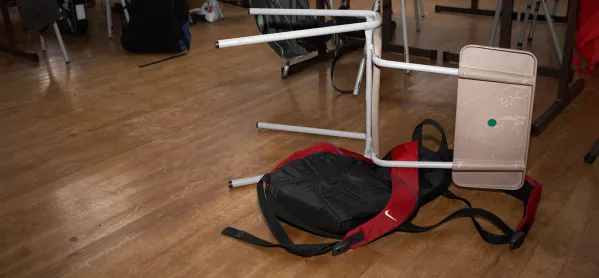- Home
- ‘To the outsider, this can look draconian’
‘To the outsider, this can look draconian’

Having watched various media and social media stories about behaviour play out over the past few months, I’m worried that we are captured in a form of doublethink - the acceptance of contrary opinions or beliefs at the same time.
On the one hand, there is a narrative that English schools are broken, that teachers at the front line are warning over pupil violence and seeking medical help over stress, and that poor behaviour is a key contributor to teachers leaving the profession. Last year, during a teaching union conference over the Easter weekend, a story that ran in several national newspapers claimed that “children as young as 4 are violently abusing staff up to six or seven times a day”.
On the other hand, there is another narrative, which proposes that zero tolerance approaches to bad behaviour in schools amount to “child abuse”. Over the same Easter weekend last year, a story ran that suggested strict rules on pupil conduct was “cruel, Victorian, Dickensian. And it punishes working class children the most”.
‘National self-harm’
These narratives intersect and play out in fascinating ways - and in ways that I worry harm our state education system. I’m not sure why, in England, we are so obsessed with bringing state education and state schools into disrepute. It feels like a form of national self-harm.
In reality, most schools and classrooms are orderly places, safe for both children and adults, where purposeful learning takes place.
But there are some schools that have failed children for generations - schools that are safe for neither children nor adults, and where learning is severely compromised. Not all schools with a judgement of “special measures” fall into this category, but a small minority do. In these schools, it is quite likely to be the case that teachers at the front line are not safe, that pupils are not safe and that their learning is compromised.
In our current system, these schools are typically subject to an “academy order” and the job of the regional schools commissioner is to find a “sponsor”. The sponsor is typically an academy trust and an education charity with a strong track record of raising standards.
Let’s imagine what might happen in one of these schools. The norms of behaviour probably match the descriptions set out in the headlines over that one Spring weekend last year. Unfortunately, behaviour may well include multiple incidents of violence and, as the story went last year, “newly qualified teachers talking about six or seven incidents during a day of abuse and the threat of violence and verbal abuse”.
What would you do?
So what do we do with these schools? If you are the trust leaders coming into a school like this, what do you do? Well, the first thing you should surely do is to establish a safe environment for both children and adults. You might often implement a behaviour policy that is seen as very strict.
In order to establish new, safe behavioural norms, you act quickly and decisively on any infraction of the rules, particularly in those crucial early weeks. But actually for quite a long time after that - our hypothetical school is probably quite vulnerable for months and even years, rather than weeks. Deeply embedded aberrant cultural and behavioural norms will quite probably resurface.
To the outsider, does this look draconian? It might. It will certainly be a huge cultural shock to the unsafe behavioural norms in the school. And yes, some may not like it, especially the very small minority of pupils whose behaviour impinges on all others. In so many cases the vast majority of pupils (and their parents) are pleased that order has been restored and that they can attend a safe school - they want to learn but their education has been disrupted, even destroyed, for so long.
I share this hypothetical example with you in order to ask the question - what would you do?
How would you ensure children and adults are safe? How would you establish new cultural and behavioural norms as quickly as possible so that you can focus on the core business of learning? Different school leaders are faced with different challenges and so will take different approaches. So above all, should we not trust our expert heads and teachers to use their experience to understand what they are faced with and to decide how to ensure their schools are safe places for their children and their staff, and to manage these complex issues?
Perhaps we need to move beyond educational doublethink and the vivid examples thereof. We need a calm, clear-headed sensible conversation. It is absolutely not right that children or adults are expected to attend or work in schools where behaviour is unsafe. We cannot simply abandon them to these behaviours. Let’s have a sensible conversation about what we think should happen.
Leora Cruddas is chief executive of the Confederation of School Trusts (CST). She tweets @LeoraCruddas
Keep reading for just £1 per month
You've reached your limit of free articles this month. Subscribe for £1 per month for three months and get:
- Unlimited access to all Tes magazine content
- Exclusive subscriber-only stories
- Award-winning email newsletters



